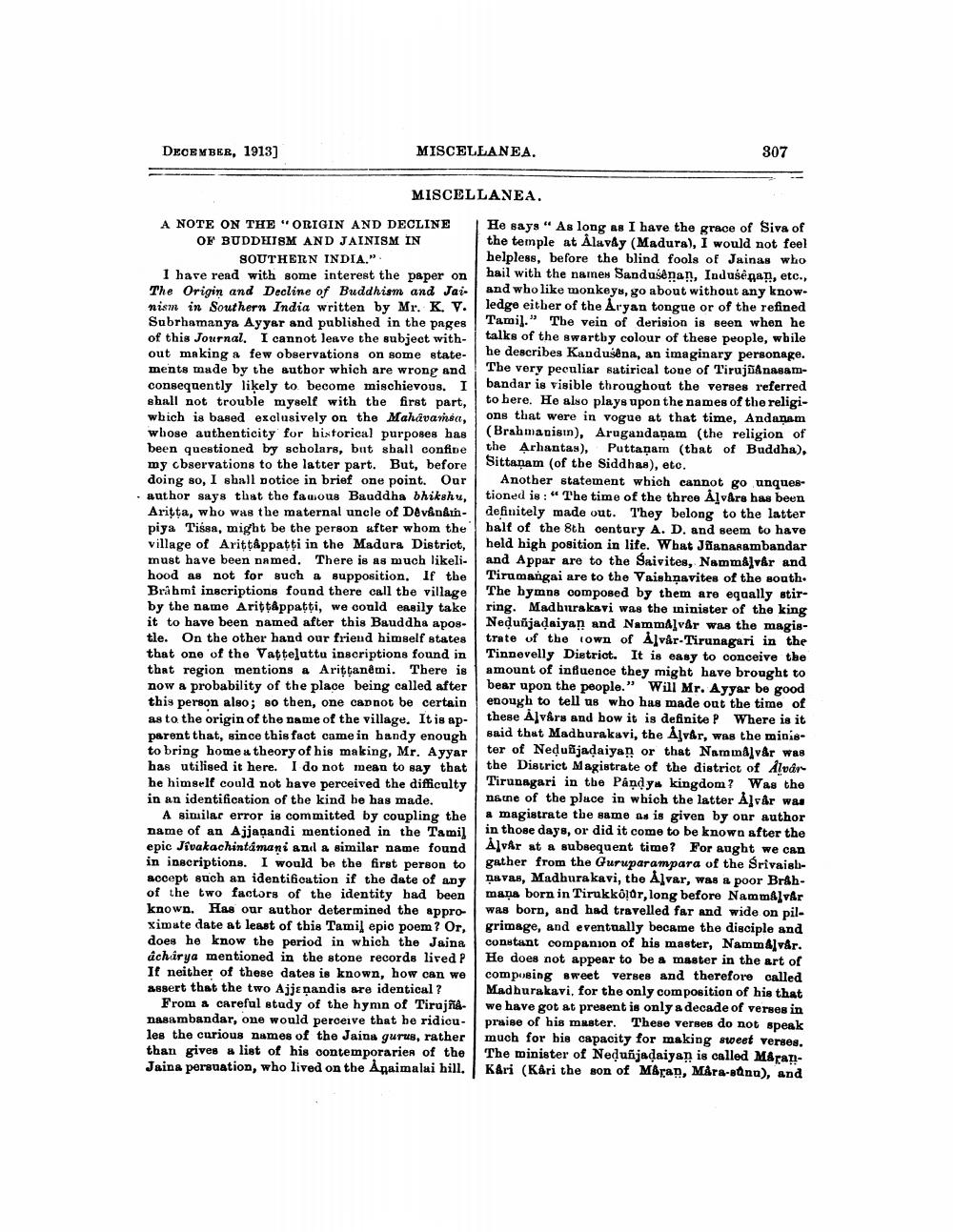________________
DECEMBER, 1913]
MISCELLANEA.
MISCELLANEA.
A NOTE ON THE "ORIGIN AND DECLINE OF BUDDHISM AND JAINISM IN SOUTHERN INDIA.".
I have read with some interest the paper on The Origin and Decline of Buddhism and Jainism in Southern India written by Mr. K. V. Subrhamanya Ayyar and published in the pages of this Journal. I cannot leave the subject without making a few observations on some statements made by the author which are wrong and consequently likely to become mischievous. I shall not trouble myself with the first part, which is based exclusively on the Mahavamia, whose authenticity for historical purposes has been questioned by scholars, but shall confine my cbservations to the latter part. But, before doing so, I shall notice in brief one point. Our author says that the famous Bauddha bhikshu, Aritta, who was the maternal uncle of Dêvânâmpiya Tissa, might be the person after whom the village of Ariṭṭâppatti in the Madura District, must have been named. There is as much likelihood as not for such a supposition. If the Brahmi inscriptions found there call the village by the name Ariṭṭappaṭṭi, we could easily take it to have been named after this Bauddha apostle. On the other hand our friend himself states that one of the Vatteluttu inscriptions found in that region mentions a Ariṭṭanêmi. There is now a probability of the place being called after this person also; so then, one cannot be certain as to the origin of the name of the village. It is apparent that, since this fact came in handy enough to bring home a theory of his making, Mr. Ayyar has utilised it here. I do not mean to say that he himself could not have perceived the difficulty in an identification of the kind he has made.
A similar error is committed by coupling the name of an Ajjapandi mentioned in the Tamil epic Jivakachintamani and a similar name found in inscriptions. I would be the first person to accept such an identification if the date of any of the two factors of the identity had been known. Has our author determined the approximate date at least of this Tamil epic poem? Or, does he know the period in which the Jaina âcharya mentioned in the stone records lived? If neither of these dates is known, how can we assert that the two Ajjɛnandis are identical?
From a careful study of the hymn of Tirujñanasambandar, one would perceive that he ridicules the curious names of the Jaina gurus, rather than gives a list of his contemporaries of the Jaina persuation, who lived on the Anaimalai hill.
307
He says "As long as I have the grace of Siva of the temple at Alavay (Madura), I would not feel helpless, before the blind fools of Jainas who hail with the names Sandusênan, Indusênan, etc., and who like monkeys, go about without any knowledge either of the Aryan tongue or of the refined Tamil." The vein of derision is seen when he talks of the swartby colour of these people, while he describes Kandusena, an imaginary personage. The very peculiar satirical tone of Tirujñanasambandar is visible throughout the verses referred to here. He also plays upon the names of the religions that were in vogue at that time, Andanam (Brahmanism), Arugandanam (the religion of the Arhantas), Puttanam (that of Buddha), Sittanam (of the Siddhas), etc.
Another statement which cannot go unquestioned is: "The time of the three Ålvårs has been definitely made out. They belong to the latter half of the 8th century A. D. and seem to have held high position in life. What Jñanasambandar and Appar are to the Saivites, Nammålvår and Tirumangai are to the Vaishnavites of the south. The hymns composed by them are equally stirring. Madhurakavi was the minister of the king Nedunjaḍaiyan and Nammålvår was the magistrate of the town of Alvår-Tirunagari in the Tinnevelly District. It is easy to conceive the amount of influence they might have brought to bear upon the people." Will Mr. Ayyar be good enough to tell us who has made out the time of these Alvårs and how it is definite? Where is it said that Madhurakavi, the Ålvår, was the minister of Neḍuñjadaiyan or that Nammålvår was the District Magistrate of the district of AlvárTirunagari in the Pandya kingdom? Was the name of the place in which the latter Ålvår was a magistrate the same as is given by our author in those days, or did it come to be known after the Alvår at a subsequent time? For aught we can gather from the Guruparampara of the Srivaishnavas, Madhurakavi, the Alvar, was a poor Bråhmana born in Tirukkôlûr, long before Nammålvår was born, and had travelled far and wide on pilgrimage, and eventually became the disciple and constant companion of his master, Nammålvår. He does not appear to be a master in the art of composing sweet verses and therefore called Madhurakavi, for the only composition of his that we have got at present is only a decade of verses in praise of his master. These verses do not speak much for his capacity for making sweet verses. The minister of Neḍuñjadaiyan is called MaranKari (Kâri the son of Maran, Mara-sanu), and




